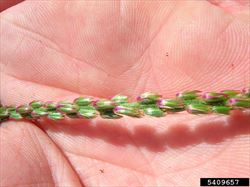- Widespread. In Australia and most Pacific island countries.
- Annual, often perennial, invasive weed found in many habitats - disturbed and cultivated land, grasslands, woodlands, forest margins, coastal areas, along roadsides, and fences. Weed of cotton, legumes, pastures, wheat; sometimes, an escape from gardens.
- Stems, up to 2m (occasionally tree-like), branched, hairy, squarish, becoming woody. Leaves, oval, up to 10cm, pointed at both ends, short stalks, hairy. Flowers, on erect spike up to 60cm, individually small, with five white, pink or greenish petal-like structures, and leaf-like bracts below. Bracts develop pointed tips.
- Spread: spines of bracts attach to animal fur, feathers, clothes. Sent internationally for use in traditional medicines.
- Biosecurity: risk is unofficial introduction of seed and plants.Available on Internet. Seeds (fruits) spiny, easily transported on animals/people/vehicles. Declared noxious weed in South Africa.
- Biocontrol: none.
- Cultural control: hand-weed or slashing; mulch (5-10cm) to prevent seedling growth; clean soil and seeds from machinery/vehicles; check clothing.
- Chemical control: in Fiji, glyphosate, 2,4-D, MCPA.














